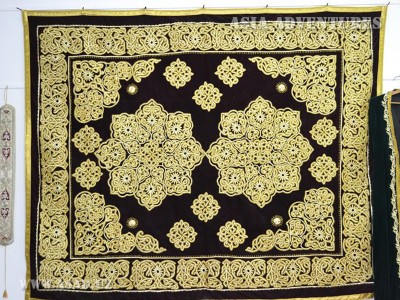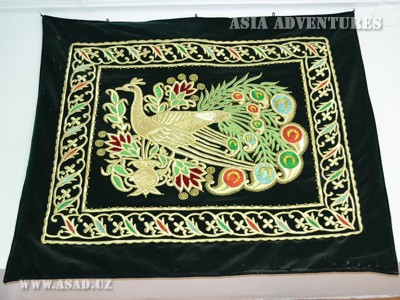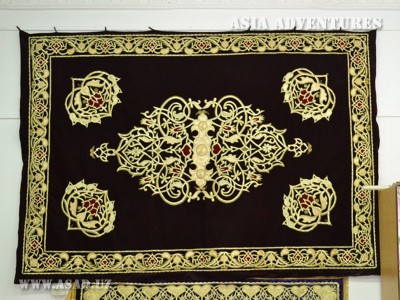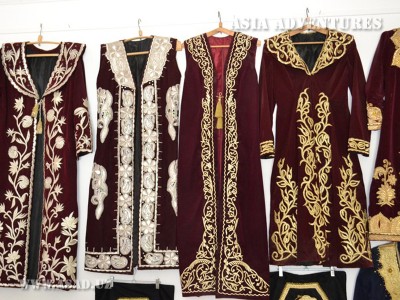 Goldwork embroidery in Uzbekistan
Goldwork embroidery in Uzbekistan
Goldwork as a world art is known for more than 20 centuries already. The territory of contemporary Uzbekistan has also been one of the world’s goldwork centres. This is evidenced by fragments of cloth excavated in Tashkent province. According to legend, goldwork was known in Sogdiana before the appearance of silk. The Arabs who captured Central Asia in the 8th century noted that the Sogdian noblemen wore clothes decorated with goldwork embroideries.
The 19th century was a peak in the development of goldwork in Uzbekistan. The centre of the craft of decoration with gold threads was Bukhara. According to literary sources, in the 2nd half of the 19th century a major goldwork embroidery workshop was located in the residence of the emir of Bukhara at the Ark. In addition, over 20 other large private workshops were functioning in this period. According to historical sources, it was mostly men who were engaged in goldwork embroidering at that time. However, if a workshop had too many orders, women, usually close relatives of the craftsmen, assisted them.
Craftsmen used to work sitting on a cotton-wool rug. A special wooden rectangular frame was used in embroidering. A zarchapan, a ceremonial robe from Bukhara decorated with goldwork, is of particular interest. Goldwork on zarchapans is always highly decorative and diverse, making each robe a unique work of art. These robes were usually worn by Bukharian emirs and noblemen. There was another type of ceremonial robe, which was presented by the emir as a favour and which was often included in ambassadors’ presents. On important occasions the emir and his court were literally dressed in gold from head to foot. The skullcap (kuloh), turban, robe, jacket, trousers, belt, boots (makhsi), kaushi and even puttee were covered all over with gold patterns. In some cases the ruler put on two or three robes at once, for which reason they were made very large. Trappings on their horses also used to gleam with gold.
The robes were made of local or imported single-colour velvet – blue, red, purple or green – and covered with goldwork. The metal thread (kalebatun) used in goldwork consisted of a very thin flattened strip of silver or other metal covered with gold and twisted tightly around a silk or cotton thread. Since ancient times gold has been a symbol of sunlight and immortality, and therefore very popular in high society. Apart from metal threads, coloured twisted and straight silk threads were used. Silk and velvet applique and projecting rosettes (kubba and kubba olmasi) of gold threads imitating jewellery also quite often adorned cloths. The threads were put upon a fabric in parallel rows and fixed to the warp with cotton or silk threads.
Apart from clothes, other household articles, such as lula-bolish (roller-shaped cushions), takyacha (pillowcases), joypush (coverlets for a wedding bed), tahmonpush (curtains for niches), joynamoz (prayer rugs), chimillik (curtains separating a part of a room) and others, were also decorated with goldwork embroidery.
Goldwork decorative patterns are highly rich and diverse, presenting both plant and geometric motifs. Some ornamental elements are based on the ideas of nature or cosmogony. Such are a kubba (small dome), mokh (the Moon), sitora (star), nishon (circle) and others. Calligraphic inscriptions often encircled ornamental compositions and were made with a high artistic skill.
Women’s clothes were also decorated often with goldwork embroidery. Gold-embroidered waistcoats from Bukhara that women wore over their dresses were very popular throughout. Dresses were decorated with bands peshkurta – strips of cloth decorated with gold embroidery, 110-120 cm long and 8-10 cm wide, halved along the longitudinal axis.
Headdresses, particularly skullcaps, were also richly decorated. A kallapushi zarduzi, a gold-embroidered skullcap which was an element of the costume of court noblemen and which later became an indispensable part of the wedding suit and the boy’s circumcision apparel, is also a specific kind of the Bukharian skullcap.
Gorgeous gold-embroidered items were often decorated with precious and semi-precious stones – diamonds, emeralds, pearls, topazes, rubies and sapphires. Gold and silver pendants of various forms also used to adorn the clothes. Small hemispherical kubba domes of gilded silver, decorated with spangles ‘pulakchi’ were also higjly popular.
Items with goldwork patterns by Bukhara masters are kept in numerous museums in Uzbekistan and other countries, such as Russia, India, Indonesia, China, Sri Lanka and others. The masters from Bukhara are regular participants of international exhibitions. Their items delight people from Great Britain, USA, India, Japan, Belgium, Syria, Sri Lanka, Germany, France and many other countries, as the goldwork on crimson or dark blue velvet brings to mind the fabulously rich traditions of the Uzbek folk art.
Nowadays, with the revival of national traditions and craftsmanship, the goldwork art is given a new life. Today, the production of goldwork embroidery usually involves women’s labour. Men’s robes decorated with goldwork are an indispensable element of a bridegroom’s costume and are often worn on ceremonial occasions and constitute a part of rich presents. There is a widest range of items decorated with goldwork embroidery: skullcaps, women’s waistcoats, shoes and handbags, cases for spectacles, cushion cases, covers for albums, bedspreads, large tapestries and theatre curtains, the last two being sometimes decorated with gold-embroidered scenes of contemporary life.

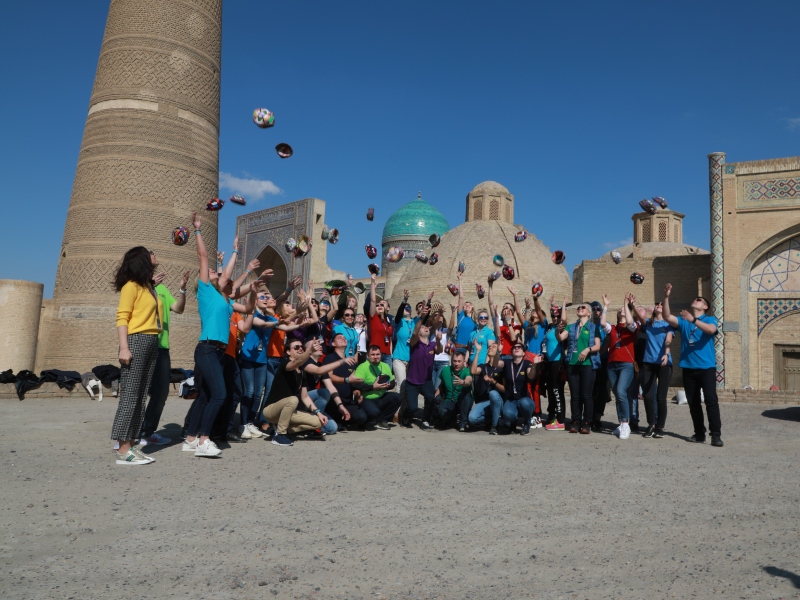 Centralasia Adventures
+998712544100
Centralasia Adventures
+998712544100




